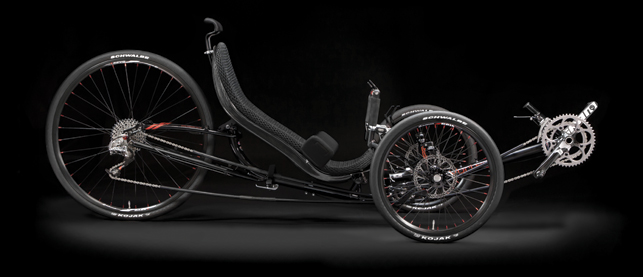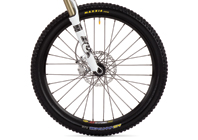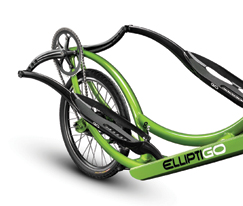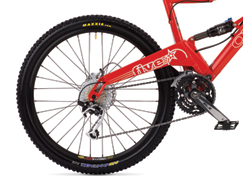Reclining standards
The recumbent cycle is visually puzzling to many, but throw in three wheels and it’s almost instantly a sportier, ground-hugging vehicle of speed.

With a laid back cycling position, the Vortex allows you to exert more force with greater ease
Despite coming to fashion in the 1970s during the fuel crisis as a comfier way for the portlier American executive to cycle to work, the recumbent trike is actually rather fast.
A ‘laid back’ posture close to the road is aerodynamically slick, and also allows the body to exert more force with greater ease.
The Inspired Cycle Engineering (ICE) Vortex definitely looks built for speed; fitted with funkier components, sportier wheels and a lightweight carbon fibre seat, it’s every inch the racing equivalent of its visually-sturdier predecessors.
It is designed as part of a modular system: the back end, the middle part of the frame and the seats are all interchangeable throughout the range. This brings a reliable solidness to the Vortex and helps the company keep stock but without compromising on the models available for a wider selection of the market.
The designs are an evolution of the company’s 25 years’ of experience with the trike, although the move into 3D modelling has paved the way for faster build times and a greater reduction in the amount of prototypes needed.
“With all the moving parts we got to a stage where 2D CAD was really holding us back and we knew that 3D was the way forward to speed up the prototyping process,” says ICE’s head designer Chris Parker.
“We now know that the first prototype is going to work because there were no clashes. 3D has made it a lot easier in the design stage.
“We can be a lot more adventurous with our designs and know they’re going to work.”
The next step is advanced testing and a higher level of FEA analysis thanks to a link up with the University of Exeter’s engineering department. A Vortex has been fitted with a number of strain gauges and is due for a punishing run out with the hope of taking the design to an even quicker level.
www.icetrikes.co
Striding out
It is big, brash, and practically a bicycle, but what makes the ElliptiGO stand out is that it takes the benefits of a cross-trainer for the gym and drags them outside.
The movements are specifically angled to mimic the running stride, benefiting the user by reducing impact injuries to those with delicate joints.
“The product itself is unique,” explains its designer Bryan Pate from the sunny climate of Solana Beach, California, himself having lost the ability to run for fitness because of hip and knee injuries after a lifetime of contact sports.
“There is no other device we know of designed to be used outdoors and emulate running without the impact. In particular, the pedalling motion is unlike any other,” he says.
Bryan showed co-founder Brent Teal his sketch done on a newspaper at a coffee shop back in 2005 and mechanical engineer Brent took over the design which soon progressed into several prototype versions, each manually tested to find the right dimensions.
Eventually a model was built in SolidWorks using the FEA abilities heavily to evaluate the structural integrity of the frame and custom components used on the bike.
Unlike a traditional diamond-frame bicycle, the ElliptiGO had to have its frame members very close together while still generating the same level of vertical stiffness.
To produce a rigid structure capable of transferring the required forces the designers turned to materials from the aerospace industry: carbon fibre is used on the drive arms and high strength 7000 series aluminium alloys are used on the frame and the crank arms.
The team has spent a lot of effort focusing on intellectual property and has filed more than a dozen patents as well as having licensed two patents from Larry Miller, the inventor of the elliptical trainer.
“It is a very cool feeling to run at 20mph!“ exclaims Bryan. We’re choosing to believe him before we pick a fight with Central London traffic.
www.elliptigo.com
Fab five
The success of a mountain bike lies in its angles, and very few are as geometrically composed and reassuringly stiff as the Five, Orange’s championship-winning trail bike.
Screaming down the side of a mountain you want the bike underneath you to do exactly what you want, otherwise you could end up grinding your face along gravel, bouncing off rocks and feeling your skin peeling off like a banana. Not nice.
The Five has been at the top of its class now for almost ten years, and the reason it has lasted so long is the ride that it offers, which comes from Orange’s commitment to working out the angles.
A strong, well-balanced frame design is the key to a responsive machine.
Orange is based in Halifax, England where the Five is also built, although the designs now come from Spain where head of design and founder Steve Wade now resides.
Beginning with 2D CAD line drawings, all the important adjustments are made to the frame. As trail bike riders have started pushing their steeds harder and applying more stresses by taking on more jumps and drops, the stronger the frame has to be.
The key changes to the 2011 model include a tapered head tube and oversized seat tube, reflecting just how much Orange expects its customers to punish the bike.
The movement provided in the suspension is calculated in 3D using SolidWorks, as is the positioning of the components such as the gears and crank set.
Although the key components are usually of an industry standard size, using a 3D model means that, should a supplier make changes, adjustments can be swiftly made to make sure clearances and pivots will work the same.
By removing clashes from the design it’s hoped that the rider will avoid clashes with the ground the next time they hit the downhill trail.
www.orangebikes.co.uk

Two wheels good – three wheels better?








